Launchspace Technologies proposes debris mitigation and collection constellations
By Debra Werner

Launchspace Technologies continues to refine its concept for establishing one constellation of satellites to track objects in orbit and a second to collect debris over the equator.
Since the company unveiled plans in 2017 to send Debris Collection Units into equatorial orbits, Launchspace Technologies has conducted a study funded by the U.S. Air Force, signed a NASA Space Act Agreement and won support from Airbus for its plan to test technology on the International Space Station’s Bartolomeo platform.
“We are positioning ourselves for the time when orbital debris becomes a real problem,” said Marshall Kaplan, Launchspace Technologies chief technology officer. “One of these days soon, we’re going to find out that we’re losing satellites at a rapid rate because of debris. At that point, it will be critical to address the debris problem because if we allow it to continue, we will lose access to space altogether.”
For Launchspace Technologies, the first task is developing a constellation of satellites equipped with sensors into equatorial low-Earth orbit to keep track of other satellites in low-Earth and geostationary orbit in addition to monitoring orbital debris and other threats, said John Bauman, Launchspace Technologies CEO.
The company plans to sell subscriptions to the data it acquires with its initial constellation to customers interested in space domain awareness, space traffic management and orbital debris mitigation, Bauman added.
Launchspace Technologies plans to establish a second constellation of satellites operating be-tween 600 and 1,200 kilometers to collect pieces of orbital debris large enough to hurt satellites but too small to be tracked with ground-based sensors.
The debris collector satellites will be designed to move out of the way to dodge active satellites and large debris, while capturing small debris, Bauman said.
Kaplan has applied for and been granted patents related to this work. In early 2020, for example, Kaplan was granted a patent to equip satellites with radial thrusters “to evade threats, such as orbital debris and/or hostile spacecraft without losing its relative position within a satellite constellation or experiencing the diminished services often attendant such maneuvers,” according to the patent.
Launchspace Technologies signed a Space Act Agreement with NASA in April to identify promising materials for collecting debris.
Kaplan envisions “a combination of plates with some filler material between the plates to absorb a lot of the energy.”
Launchspace Technologies plans to test its multilayer debris-collection technology for 12 months on Bartolomeo beginning in 2022. Airbus, which developed Bartolomeo and operates it with European Space Agency support, called the Launchspace Technologies demonstration mission “a bold step toward advancing the state of the art for debris collection and mitigation technologies and techniques,” in a Sept. 15 letter to Bauman.
Under the terms of the contract, Launchspace Technologies is paying fees to house its technology on Bartolomeo, but Airbus is not charging the company for transportation, astronaut crew time and other ISS resources.
Robert Walker, former House Science Committee chairman and former executive chairman of the Washington lobbying firm Wexler & Walker Public Policy Associates, began working with Launchspace Technologies to rally support for the company’s work.
Now, Walker, who founded moonWalker Associates in 2019, has joined the Launchspace Technologies board.
“I think the concept that they have is absolutely correct,” Walker said. “At the highest level both in the military and at NASA, no one has any real objections to this program. We are getting positive signals from the government, but we haven’t found an agency that’s prepared to step up with funding yet.”
This article originally appeared in the Nov. 16, 2020 issue of SpaceNews magazine.
November 30, 2020 at 10:26PM
via SpaceNews read more...

Post a Comment